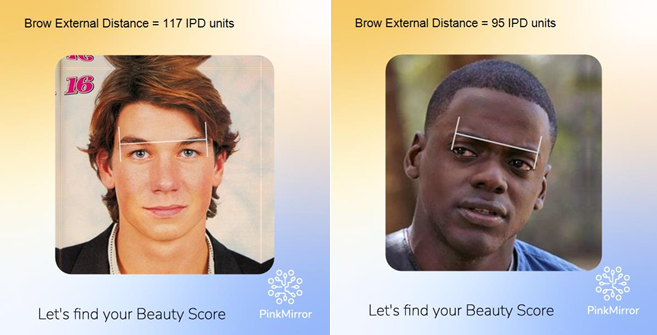Summary The bi-gonial width (distance between jaw’s lateral points) and bi-zygomatic width (distance between cheekbones’ lateral points) determine facial shape, differing in males and females. Altman (2012) found males have wider bi-gonial widths due to angular jaws, resulting in a larger bi-gonial to bi-zygomatic ratio. Lakhiani and Somenek (2019) observed that males’ inter-zygomatic width equals […]
Category: Golden Proportion
Summary The face height middle-third to lower-third ratio is crucial in facial aesthetics and attractiveness, comparing the middle third (eyebrows to nose base) to the lower third (nose base to chin) of the face. Lakhiani & Somenek (2019) noted that females typically have a smaller mandibular width and angle flare, a rounder and smaller chin, […]

Summary In the realm of facial aesthetics, longer eyebrows are seen as a hallmark of masculinity. Gupta et al. (2017) in their study published in the Journal of Cutaneous and Aesthetic Surgery noted that the average eyebrow length for men is 5.5 cm compared to 5.0 cm for women. This indicates that longer eyebrows contribute […]
Summary A larger ratio of mouth-width to nose-width is considered attractive. Research shows that the width of a person’s mouth compared to their nose can influence how attractive they’re perceived to be. Dawei et al. study in 1997 found that a mouth width about 1.5 times larger than the nose width is generally seen as […]
Summary A small ratio of Interpupillary-Width to Bi-zygomatic-Width is considered attractive for males, whereas, a larger ratio is considered as attractive for females. Research spanning various journals has delved into facial differences between males and females. Velemínská et al. (2012) in the Journal of Comparative Human Biology discussed how puberty in males, influenced by testosterone, […]
Summary Research has shown that a smaller bi-gonial width, the distance between the jaw’s two angles, is deemed attractive in females due to the resulting narrower facial appearance. Little et al. (2011) suggested a smaller bi-gonial width might be seen as attractive in females because it’s a pronounced female trait. Additionally, Jung et al. (2018) […]
Summary Three studies explore the role of eye size in perceptions of attractiveness and personality in males. Paunonen et al. (1999) suggest that larger eyes, associated with babyface features, are perceived as feminine, leading to personality attributions like honesty, agreeableness, and low dominance. Conversely, smaller eyes enhance perceived masculinity by lessening these associations. Cunningham et […]

Summary Two recent studies explore key differences in male and female facial structures. The study by Faria et al. (2022) finds that males have a larger bi-temporal width, the distance between the temples, contributing to a wider face. This width often aligns with the bi-gonial distance (width of the lower jaw), leading to a more […]
Summary Thicker eyebrows are deemed more attractive in females, according to several studies. A study from Oakland University revealed that thicker eyebrows were seen as more attractive in women and influenced perceived attractiveness more than eye size or cheekbone prominence. Similarly, research based on Korean brow salon visitors indicated that thick eyebrows, which appear youthful […]
Summary A wider margin between eye and eyebrow is considered a feminine feature, while a shorter one is a masculine one. The position and shape of eyebrows and the structure of eyelids play significant roles in differentiating feminine and masculine facial features, according to research by Patel and Malhotra (2021), and Lakhiani & Somenek (2019). Women […]